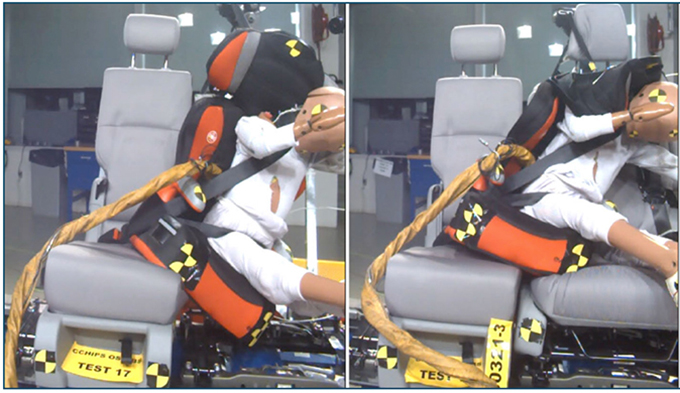Principal Investigator: Julie Mansfield, PhD, The Ohio State University
WHAT WAS THE PURPOSE OF THIS PROJECT AND HOW WAS IT CONDUCTED?
Today’s vehicle fleet features increasingly adaptable vehicle interiors, particularly in family vehicles. The CChIPS IAB was interested in investigating how CRS interact with the adjacent vehicle seat and if the position of the vehicle seat has an impact on CRS performance in a crash.
Dynamic side impact sled tests were conducted to define the performance outcomes of rear-facing (RF) and forward-facing (FF) CRS and belt-positioning boosters (BPB) in these conditions. Using vehicle seats from an IAB member company, a CRS or BPB was installed in either the outboard or center position with the adjacent seat either upright, folded, or removed. We analyzed the resulting kinematics, or movement, of the child seat and the ATD.
WHAT DID YOU FIND?
The outboard vehicle seat tended to better support the child restraints in terms of the width and lateral movement of CRS. When CRS were installed in the narrower center position, there was overhang of the CRS relative to the vehicle seat that impacted testing performance; those CRS moved farther to the side and off the vehicle seat cushion. We found substantial movement in the BPB, in particular. However, we also found that adjacent upright vehicle seats helped to control the motion of the CRS bases.
Our results provide additional evidence to support use of the top tether for a FF CRS; the tether helped to stabilize the child restraint, which is particularly important in a condition where the side of the CRS isn’t fully supported by the vehicle seat.
WAS ANYTHING SURPRISING?
One thing that surprised us was just how far the CRS moves laterally during a crash. We observed evidence of lower anchor deformation when the RF CRS was installed on a narrow center seat with no adjacent seat to limit the downward movement of the CRS. That is an important design concept for vehicle manufacturers and CRS manufacturers to keep in mind — to ensure that the hardware can accommodate those lateral motions.
WHAT’S NEXT?
Based on the findings of this study, a 2019-2020 CChIPS project will investigate LATCH vs. non-LATCH installations for BPBs in impacts.
Student
Gretchen Baker, The Ohio State University
IAB Mentors
Susan Mostofizadeh, American Honda Motor Co., Inc.; Emily Thomas, Consumer Reports; Suzanne Johansson, General Motors Holdings LLC; Mark LaPlante, Graco Children’s Products Inc.; Justin Robinson, Graco Children’s Products Inc.; Russ Davidson, Lear Corporation; Schuyler St. Lawrence, Toyota USA; HyunJung Kwon, Transportation Research Center; Julie Kleinert, Technical Advisor; Uwe Meissner, Technical Advisor

